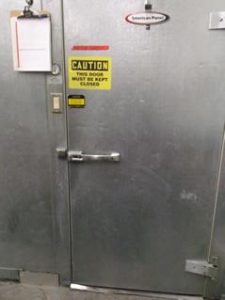Safety on Tap! – Chapter 2
By Terry Botts
Occupational Health & Safety Consultant
In general industry the health hazards associated with C02 are well known and well documented. After visiting dozens and dozens of craft breweries, unfortunately, in most cases the dangers of C02 are either unknown or just ignored. Because of this, people continue to die needlessly in tragic and totally avoidable accidents in breweries throughout the world.
C02 tanks are often placed in cramped, out-of-the-way spaces that would easily pose a place for leaks to go undetected and allow a hazard to lay in wait.

C02 tanks are often placed in storage rooms and enclosed spaces where a leak could lead to disaster.
Properties and effects of CO2
C02, a colorless, odorless by-product of the fermentation process, is extremely hazardous and can kill in two ways: either by displacing oxygen or as a toxin. Exposure to levels as little as .5% volume C02 is a serious toxic health hazard and concentrations greater than 10% volume C02 can be fatal.
C02 is heavier than air and collects at the bottom of tanks, cellars, confined spaces, containers, low lying areas and can even spill out of fermenting tanks and sink to the brewery floor, where it forms deadly, invisible pockets. Because C02 is completely odorless and colorless, there is no physical indication or warning of danger until it is usually too late.
Safety precautions
Wort tanks, fermentation tanks, beer mixing tanks, silos, walk in coolers and other identified confined spaces are easily accessible – it is rare for them to be fitted with safety interlocks. For this very reason rigorous safety procedures should be in place and always followed. Employers are responsible for assessing the risks these areas pose to their employees and undertaking measures to eliminate them. Having the required written Respiratory Protection, Lockout/Tagout and Confined Space entry programs and procedures along with proper training is critical to manage the dangers.

Walk-in coolers can be a death trap to unsuspecting workers.
Gas Detection
Both portable and fixed CO2 detectors, alarms and ventilation fans can be used in CO2 monitoring in breweries. Fixed systems typically comprise one or more detector “sensors” connected to a separate main control panel. If a ”sensor“reads a dangerous CO2 level, extractor fans are automatically triggered and sirens or visual beacons can also be activated to warn workers to vacate the area. This sort of installation is suited to larger spaces like cellars and storage areas.
Portable compact units are required in confined space work where fixed detectors cannot be installed. The portable units should be easy to use and proper training should take place prior to issuing an employee a portable gas detector. Combining one or more sensors with powerful audible and visual signals to warn when pre-set gas levels are reached, compact portable detectors are easily carried in a confined space, ensuring that pockets of high CO2 concentration are not missed.


Portable gas detectors and ventilation fans are part of the arsenal in fighting atmospheric hazards in the workplace.
How to get there
Not taking C02 dangers seriously leads to unnecessary, avoidable workplace deaths. Having the required written Health & Safety programs, policies, procedures and training in place will give you all the tools to manage this occupational hazard.
If you are a business owner and don’t know what to do or where to turn, contact an Occupational Health and Safety consulting firm. A good Safety Consultant can help a Craft Brewer develop and manage their required Health & Safety programs.
About the Author:
Terry Botts is a business and safety consultant with over 25 years’ practical experience in the Manufacturing, Construction and more recently craft brewers industry. Terry is an Occupational Hearing Conservationist and an Authorized OSHA Outreach Instructor and can provide OSHA 10 & 30 Hour General Industry and Construction Outreach Training programs. Terry has been developing comprehensive safety programs, conducting site safety inspections, and delivering specialized safety training for a wide range of business clients since 2005.


